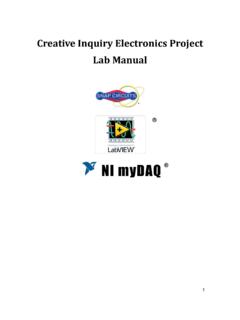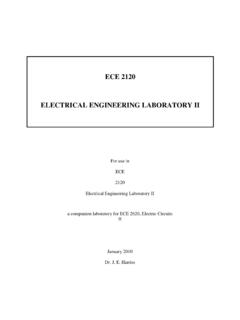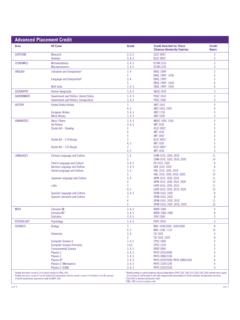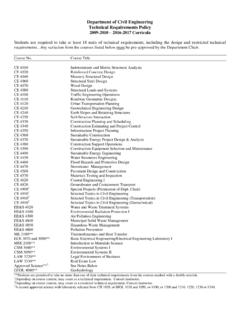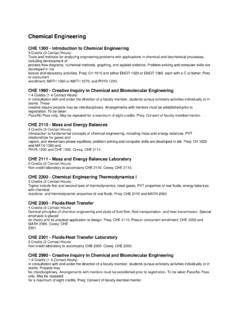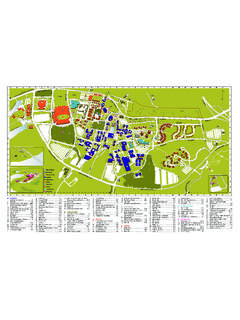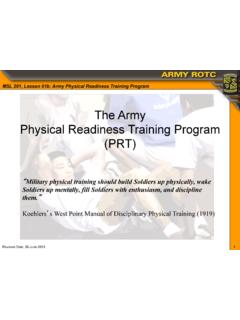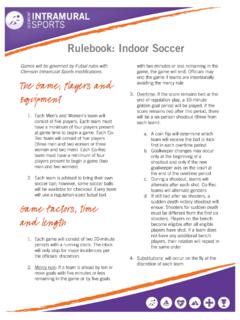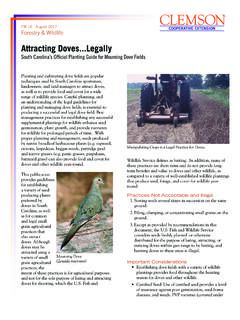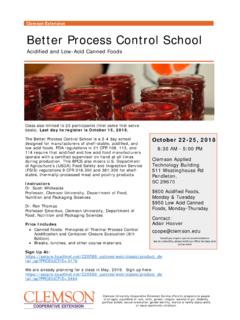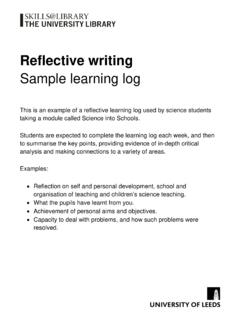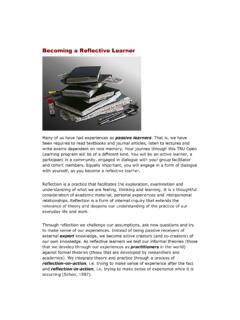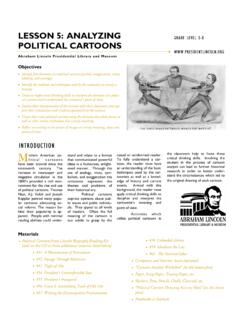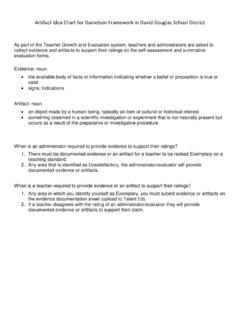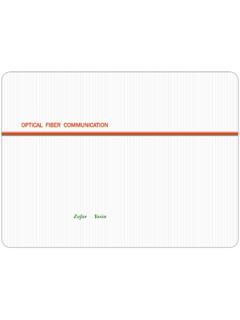Transcription of REFLECTION ACTIVITIES - Clemson University
1 REFLECTION ACTIVITIES Contents REFLECTION ACTIVITIES for Prior Knowledge (used prior to engaging students in subject or topic).. 1 REFLECTION ACTIVITIES for Cognition: .. 2 Reflective ACTIVITIES for Metacognition .. 3 REFLECTION ACTIVITIES for Competency: .. 4 Reflective ACTIVITIES for Personal Growth and Change .. 5 REFLECTION ACTIVITIES for Prior Knowledge (used prior to engaging students in subject or topic) *3-2-1: Have students list three things you already know about X, two things you d like to know about or learn more about, and one question related to the key concept or learning. *Checklists: Develop a list of key concepts, ideas, definitions that students might know about the topic/subject to be discussed. Have students answer to what degree that feel that already understand these ideas. *KWL: Begin the lesson with a three-column organizer: What I Know, What I Want to know, what I Learned. Have students fill in the first two columns in advance of the lesson. Return to the last column as a summarizing strategy for the lesson.
2 *Misconception Check: Present students with common or predictable misconceptions about a designated concept, principle, or process. Ask them whether they agree or disagree and explain why. The misconception check can also be presented in the form of a multiple-choice or true-false quiz. Story Board: Give students a blank story board and ask them to create a non-linguistic version of what they already know about the topic/essential question for an impending lesson, filling the blocks of the story board with stick figures, drawings, etc. in an appropriate sequence. REFLECTION ACTIVITIES for Cognition: Concept Maps: Concept maps are visual diagrams representing how a particular concept or idea is related to other ideas, terms, topics, or processes. Have student build concept maps that visually represent the ideas and information that were covered in that's week's class. Students can do this individually or in small groups. Chris Ray, a student at Waterloo, explains how he used a concept mapping tool to take class notes here.
3 *One Sentence Summary: Students are asked to write a summary sentence that answers the who, what where, when, why, how questions about the topic. *Quick-Write: The strategy asks learners to respond in 1-2 minutes to an open-ended question or prompt posed by you before, during, or after reading. Also referred to as the one-minute paper. *Take and Pass: Cooperative group activity used to share or collect information from each member of the group; students write a response, then pass to the right, add their response to next paper, continue until they get their paper back, then group debriefs. *Exit Card: Exit cards are written student responses to questions posed at the end of a class or learning activity or at the end of a day. Journals: Journals may be written as private, individual journals with general prompts or prompts specific to the current lesson. Variations on the basic journal include methods of sharing and commenting done by peers. For the double-entry journal, students draw a line or divide their page in half, write a journal entry, and then a peer reacts and comments on the other side.
4 In a triple-entry journal, students journal on their learning on one third of a page, a peer responds in the second area, and the student then analyzes their own entry and the peer response in the final third of the page. Reflective Essays: To make the learning more personal, have students write a reflective essay. A reflective essay should require the student to connect their personal experience to course content. It is written in essay format (rather than a more free-form journal format) and can be graded for REFLECTION that incorporates critical thinking techniques and use of supporting details from course content. The Mirror, Microscope and Binoculars: This activity follows a series of questions to allow students to look at themselves (mirror), the experience (microscope), and the greater picture (the binoculars). The questions can be discussed out loud or written first and then discussed. Use the analogy of mirror, microscope, and binoculars to structure the learning. Force Field Analysis: Force Field Analysis is a general tool for systematically analyzing the factors found in problems.
5 It frames problems in terms of factors or pressures that support the status quo (restraining forces) and those pressures that support change in the desired direction (driving forces). There are four steps to the process: (1) Defining the Problem, (2) Defining the Change Objective, (3) Identifying the Forces that Support Change, and (4) Identifying the Forces that Support Maintaining the Status Quo. Reflective ACTIVITIES for Metacognition Exam Wrappers: After a graded exam, give students a reflective sheet where they can describe their study strategies, analyze the mistakes they made, and plan their study strategies for the next exam. These REFLECTION sheets are returned to students before the next exam, so that they can make use of the ideas they had when the previous exam was still fresh in their minds. Students identified several new approaches they would use in future exam preparation. *Self-Assessment: A process in which students collect information about their own learning experience, analyze what it reveals about their progress toward the intended learning goals and plan the next steps in their learning.
6 Similar to an exam wrapper, students write goals for a unit or assignment, create a plan, and monitor their process. Students can be asked to share effective learning strategies using this method. *Stop and Switch: At the end of class, ask students to write down five things they have learned (2 minutes). Second, ask them to find a partner; tell one student to talk for 2 more minutes about what he/she has learned. At the end of those two minutes, call for a STOP/SWITCH. The other student now talks for 2 minutes but is not permitted to repeat anything that has been stated by his/her partner. After those 2 minutes, call for a STOP/SWITCH. Begin the cycle again with new partners and the same rules (not repeating what another student has said) but now for only one minute. Do the same for the other partner for one minute (call STOP/SWITCH). Finally, at the end of those two, one-minute intervals, ask each pair to now take 30 seconds to write one sentence that summarizes what they have learned (collectively).
7 Transfer Journal: Students create or fill in a chart of basic concepts learned in class and then state how these concepts will apply / transfer to new ideas or areas. Have students fill out the chart for a concept or multiple concepts. ORID method: This model (Stanfield, 1997) moves students through reflective questions, following the Kolb experiential learning cycle: Objective / Reflective / Interpretive / Decisional. First, students reflect on a learning experience objectively, describing what they did, observed, or read. They reflect next on how they felt, what they were reminded of, how they connect with their values, and other affective questions. Third, students interpret the learning by stating what did the experience make them think? How did their thinking change? And fourth, students are asked about future decisions: how did the learning affect their skills or understanding? What will change for them in the future (what will they do differently?). REFLECTION ACTIVITIES for Competency: Portfolio: This type of documentation has become a vital way for students to keep records and learn organizational skills.
8 Students gather artifacts of their learning experience along with written responses and REFLECTION to provide evidence of their learning. Depending on the course items may include: photographs, videos, assignments, transcripts of interviews, completed projects. Require them to make this professional. For service learning especially, student portfolios could contain any of the following: service-learning contract, weekly log, personal journal, impact statement, directed writings, photo essay. Also, any products completed during the service experience ( , agency brochures, lesson plans, advocacy letters) should be submitted for review. Finally, a written evaluation essay providing a self-assessment of how effectively they met the learning objectives of the course is suggested for the portfolio. Concept Maps: Please see description above; filling out a structured concept map can allow students to show competency with a topic in detail, with relational aspects visualized. Video Presentation: Have students develop a video that reflects their learning.
9 Students can use images, with text and audio, that are then automatically advanced (a glideshow ) or students can create Vlogs using a cell phone or laptop video capture as they narrate their conceptual learning. Screen capture of data or other information is also an option. Students can use free apps or Adobe and other University -supplied software. One shot video will naturally have different production quality than a developed slide show or edited video. It s Your Thing, Express Yourself: Tell the students that they will have the opportunity to create their own version of their feelings toward a project (appropriate for service learning). Examples could include poetry, visual art, (paintings, drawings, sculptures) music, (rap is a rather popular choice for this exercise), individually created games or puzzles, any form of creative outlet that gives the student the chance to perform or explain in front of the class is what you are looking for. Be sure to require that it must be some kind of individual work that he/she has created.
10 Reflective ACTIVITIES for Personal Growth and Change *3-Minute Pause: The Three-Minute Pause provides a chance for students to stop, reflect on the concepts and ideas that have just been introduced, make connections to prior knowledge or experience, and seek clarification. Questions include: I changed my attitude about I am more aware of I was surprised about I felt I related to I empathized with *Self-Assessment: A process in which students collect information about their own learning experience, analyze what it reveals about their progress toward the intended learning goals and plan the next steps in their learning. *Sentence Stems: REFLECTION Stems for the start of class, which students write out and save for the end of class. Example: "Today I " or "I am most anxious " Students can be asked what they need further, at the end of class. *What? So What? Now What?: This process facilitates critical analysis of a given circumstance or experience. It allows the student to begin to make meaning and take initial steps towards developing a plan of action to address the concern.
